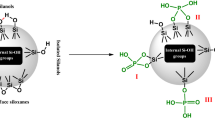Abstract
The reaction of phlogopite with a trimethylsilylating reagent yielded organosilicate compounds which are soluble in various organic solvents. Gas chromatographic analysis of the soluble products indicates that they consist of the trimethylsilylated derivatives of silicic acids which have been formed in the decomposition of phlogopite by hydrochloric acid and that silicic acids formed by the acid attack are monomelic and also oligomeric. The increase of the ratio of GC peak areas of monomer derivative to dimer one with an increase of the reaction time shows that silicic acids in the reaction system tend to depolymerize. The difference between phlogopite and biotite in the ease of trimethylsilylation also is discussed.
Абстракция
В результате реакции флогопита с триметилсилиловыми реагентами образовались органосиликатные соединения, растворимые в различных органических растворах. Газо- хромотографический анализ растворимых продуктов указывал, что они состоят из триметилсилиловых дериватов кремниевых кислот, которые образовывались при разложении флогопита соляной кислотой и что кремниевые кислоты, формировавшиеся под воздействием соляной кислоты,были мономерными и полимерными. Возрастание отношения мономерного деривата к димерному в пиковых зонах газовых хромотограмм с возрастанием времени реакции показывало, что кремниевые кислоты в реакционной системе проявляли тенденцию к деполимеризации. Обсуждается также различие между флогопитом и биотитом по способности к триметилсилилизации.
Zusammenfassung
Die Reaktion von Phlogopit mit einem Trimethylsilylierungsrea-genz ergab Organosilikatsubstanzen, die in verschiedenen organischen Lösungsmitteln löslich waren. Gas chromatographische Analysen deuteten an, daß sie aus den trimethylsilylierten Derivaten der Kieselsäuren bestehen, welche während des Abbaus von Phlogopit durch Salzsäure geformt wurden und, daß Kieselsäuren, die durch Säureabbau geformt wurden, monomerisch und oligomerisch waren. Die Zunahme des Verhältnisses der GC Signalflächen der monomeren zu denen der oligomeren mit Zunahme der Reaktionszeit, zeigt, daß Kieselsäuren in diesem Reaktionssystem, die Tendenz haben, zu depolymerisieren. Der Unterschied zwischen Phlogopit und Biotit mit Hinsicht auf die Leichtigkeit, mit der Tri-methylsilylierung stattfindet, wurde auch diskutiert.
Résumé
La réaction de phlogopite avec un réactif triméthylsilylatant a produit des composés organosilicés qui sont solubles dans divers solvants organiques. L’analyse chromatographique à gaz des produits solubles indique que ces derniers consistent en dérivatifs triméthylsilylatés d’acides siliciques qui ont été formés par la décomposition de phlogopite par l’acide hydrochlorique,et les acides siliciques formés par l’attaque acide sont monomériques et également oligomériques. Le fait que le rapport des régions des pics de GC du dérivatif monomère à celui du dérivatif dimère augmente avec l’augmentation du temps de réaction montre que les acides siliciques ont tendance à se dépolymériser dans ce système de réaction. La difference entre la facilité de triméthylsilylation de phlogopite et de biotite est aussi discutée.
Similar content being viewed by others
References
Currell, B. R., Midgley, H. G., Seaborne, M. A. and Thakur, C. P. (1974) Preparation of polyorganosiloxane from mineral silicates using the method of trimethylsilylation: Br. Polym. J. 6, 229–240.
Garzô, G. and Hoebbel, D. (1976) Gas chromatographic retention characteristics of trimethylsilylated silicate anions: J. Chromatogr. 119, 173–179.
Götz, J. and Masson, C. R. (1970) Trimethylsilyl derivatives for the study of silicate structures. Part 1. A direct method of trimethylsilylation: J. Chem. Soc. Inorg. Phys. Theor. 2683–2686.
Götz, J. and Masson, C. R. (1971) Trimethylsilyl derivatives for the study of silicate structures. Part 2. Orthosilicate, pyrosilicate and ring structures: J. Chem. Soc. (A) 686–688.
Kuroda, K. and Kato, C. (1977) Trimethylsilylation of biotite: Clays & Clay Minerals 25, 407–410.
Lentz, C. W. (1964) Silicate minerals as sources of trimethylsilyl silicates and silicate structure analysis of sodium silicate solutions: Inorg. Chem. 3, 574–579.
Murata, K. J. (1943) Internal structure of silicate minerals that gelatinize with acid: Am. Mineral. 28, 545–562.
Wu, F. F. H., Götz, J., Jamieson, W. D. and Masson, C. R. (1970) Determination of silicate anions by gas chromatographic separation and mass spectrometric identification of their trimethylsilyl derivatives: J. Chromatogr. 48, 515–520.
Author information
Authors and Affiliations
Rights and permissions
About this article
Cite this article
Kuroda, K., Kato, C. Preparation of Organosilicate Compounds from Phlogopite by Trimethylsilylation. Clays Clay Miner. 26, 418–422 (1978). https://doi.org/10.1346/CCMN.1978.0260605
Received:
Published:
Issue Date:
DOI: https://doi.org/10.1346/CCMN.1978.0260605



